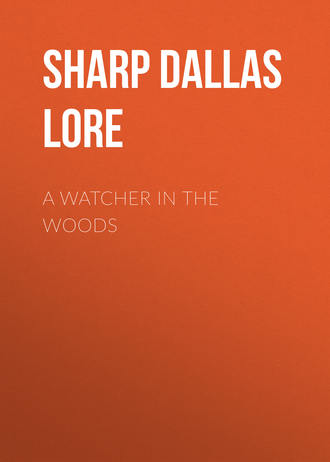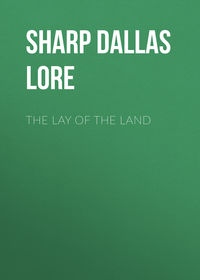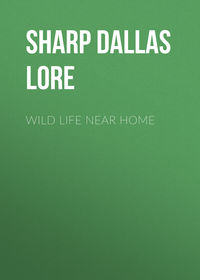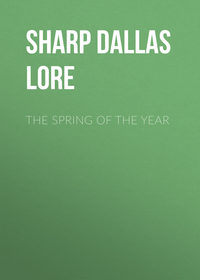 полная версия
полная версияA Watcher in The Woods
There was not a croak, not a squeak, not the slightest sound, save the small pit-pat, pit-pat, made by their hopping. There may have been some kind of toad talk among them, but listen never so closely, I could not catch a syllable of it.
Where did they all come from? How did they find their way to this wet spot over the hills and across the acres of this wide pasture? You could walk over the field in the daytime and have difficulty in finding a single toad; but here at night, as I lay watching, every few minutes one would hop past me in the grass; or coming down the narrow cow-paths in the faint light I could see a wee black bunch bobbing leisurely along with a hop and a stop, moving slowly toward the pump to join the band of his silent friends under the trough.
Not because there was more food at the pump, nor for the joy of gossip, did the toads meet here. The one thing necessary to their existence is water, and doubtless many of these toads had crossed this pasture of fifteen acres simply to get a drink. I have known a toad to live a year without food, and another to die in three days for lack of water. And yet this thirsty little beast never knows the pleasure of a real drink, because he does not know how to drink.
I have kept toads confined in cages for weeks at a time, never allowing them water when I could not watch them closely, and I never saw one drink. Instead, they would sprawl out in the saucer on their big, expansive bellies, and soak themselves full, as they did here on the damp sand about the pump.
Just after sunset, when the fireflies light up and the crickets and katydids begin to chirp, the toad that sleeps under my front step hops out of bed, kicks the sand off his back, and takes a long look at the weather. He seems to think as he sits here on the gravel walk, sober and still, with his face turned skyward. What does he think about? Is he listening to the chorus of the crickets, to the whippoorwills, or is it for supper he is planning? It may be of the vicissitudes of toad life, and of the mutability of all sublunary things, that he meditates. Who knows? Some day perhaps we shall have a batrachian psychology, and I shall understand what it is that my door-step lodger turns over and over in his mind as he watches the coming of the stars. All I can do now is to minute his cogitations, and I remember one evening when he sat thinking and winking a full hour without making a single hop.
As the darkness comes down he makes off for a night of bug-hunting. At the first peep of dawn, bulging plump at the sides, he turns back for home. Home to a toad usually means any place that offers sleep and safety for the day; but if undisturbed, like the one under the step, he will return to the same spot throughout the summer. This chosen spot may be the door-step, the cracks between the bricks of a well, or the dense leaves of a strawberry bed.
In the spring of 1899 so very little rain fell between March and June that I had to water my cucumber-hills. There was scarcely a morning during this dry spell that I did not find several toads tucked away for the day in these moist hills. These individuals had no regular home, like the one under the step, but hunted up the coolest, shadiest places in the soft soil and made new beds for themselves every morning.
Their bed-making is very funny, but not likely to meet the approval of the housewife. Wearied with the night's hunting, a toad comes to the cool cucumber-vines and proceeds at once to kick himself into bed. He backs and kicks and elbows into the loose sand as far as he can, then screws and twists till he is worked out of sight beneath the soil, hind end foremost. Here he lies, with only his big pop-eyes sticking out, half asleep, half awake. If a hungry adder crawls along, he simply pulls in his eyes, the loose sand falls over them, and the snake passes on.
When the nights begin to grow chilly and there are threatenings of frost, the toads hunt up winter quarters, and hide deep down in some warm burrow – till to-morrow if the sun comes out hot, or, it may be, not to wake until next April. Sometimes an unexpected frost catches them, when any shelter must do, when even their snake-fear is put aside or forgotten. "Misery acquaints a man with strange bedfellows," said Trinculo, as he crawled in with Caliban from the storm. So might the toad say in an early frost.
The workmen in a sandstone-quarry near by dug out a bunch of toads one winter, all mixed up with a bunch of adders. They were wriggled and squirmed together in a perfect jumble of legs, heads, and tails – all in their dead winter sleep. Their common enemy, the frost, had taken them unawares, and driven them like friends into the crevice of the rocks, where they would have slept together until the spring had not the quarrymen unearthed them.
There is much mystery shrouding this humble batrachian. Somewhere in everybody's imagination is a dark cell harboring a toad. Reading down through literature, it is astonishing how often the little monster has hopped into it. There is chance for some one to make a big book of the fable and folk-lore that has been gathering through the ages about the toads. The stories of the jewels in their heads, of their age-long entombments in the rocks, of the warts and spells they induce, of their eating fire and dropping from the clouds, are legion.
And there seems to be some basis of fact for all these tales. No one has yet written for us the life-history of the toad. After having watched the tadpole miracle, one is thoroughly prepared to see toads jump out of the fire, tumble from broken marble mantles, and fall from the clouds. I never caught them in my hat during a shower; but I have stood on Mauricetown Bridge, when the big drops came pelting down, and seen those drops apparently turn into tiny toads as they struck the planks, until the bridge was alive with them! Perhaps they had been hiding from the heat between the cracks of the planks – but there are people who believe that they came down from the clouds.
How, again, shall I explain this bit of observation? More than six years I lived near a mudhole that dried up in July. I passed it almost daily. One spring there was a strange toad-call in the hole, a call that I had never heard anything like before – a deafening, agonizing roar, hoarse and woeful. I found on investigation that the water was moving with spade-foot toads. Two days later the hole was still; every toad was gone. They disappeared; and though I kept that little puddle under watch for several seasons after that, I have not known a spade-foot to appear there since.
The water was almost jellied with their spawn, and a little later was swarming with spade-foot tadpoles. Then it began to dry up, and some of the tadpoles were left stranded in the deep foot-prints of the cows along the edge of the hole. Just as fast as the water disappeared in these foot-prints, the tails of the tadpoles were absorbed and legs formed, and they hopped away – some of them a week before their brothers, that were hatched at the same time, but who had stayed in the middle of the pond, where the deeper water allowed them a longer babyhood for the use of their tails. So swiftly, under pressure, can nature work with this adaptable body of the toad!
Long before the sun-baked mud began to crack these young ones had gone – where? And whence came their parents, and whither went they? When will they return?
RABBIT ROADS
In your woods walks did you ever notice a little furrow or tunnel through the underbrush, a tiny roadway in the briers and huckleberry-bushes? Did you ever try to follow this path to its beginning or end, wondering who traveled it? You have, doubtless. But the woods must be wild and the undergrowth thick and you must be as much at home among the trees as you are in your own dooryard, else this slight mark will make no impression upon you.
But enter any wild tract of wood or high swamp along the creek, and look sharp as you cut across the undergrowth. You will not go far before finding a narrow runway under your feet. It is about five inches wide, leading in no particular direction, and is evidently made by cutting off the small stems of vines and bushes at an inch or more from the ground. The work looks as if it had been laid out by rule and done with a sharp knife, it is so regular and clean.
This is a rabbit road. Follow it a few rods and you will find it crossed by another road, exactly similar. Take this new path now, and soon you are branching off, turning, and joining other roads. You are in rabbit-land, traveling its highways – the most complicated and entangling system of thoroughfares that was ever constructed. The individual roads are straight and plain enough, but at a glance one can see that the plan of the system is intended to bewilder and lead astray all who trespass here. Without a map and directions no one could hope to arrive at any definite point through such a snarl.
There often comes along with the circus a building called the "Moorish Maze," over whose entrance is this invitation:
COME IN AND GET LOST!This is what one reads at the cross-roads in rabbit-land. There are finger-boards and milestones along the way; but they point nowhere and mark no distances except to the rabbits.
An animal's strong points usually supplement each other; its well-developed powers are in line with its needs and mode of life. So, by the very demands of his peculiar life, the beaver has become chief among all the animal engineers, his specialty being dams. He can make a good slide for logging, but of the construction of speedways he knows absolutely nothing. The rabbit, on the other hand, is a runner. He can swim if he is obliged to. His interests, however, lie mostly in his heels, and hence in his highways. So Bunny has become an expert road-maker. He cannot build a house, nor dig even a respectable den; he is unable to climb, and his face is too flat for hole-gnawing: but turn him loose in a brambly, briery wilderness, and he will soon thread the trackless waste with a network of roads, and lay it open to his nimble feet as the sky lies open to the swallow's wings.
But how maddening these roads are to the dogs and foxes! In the first place, they have a peculiar way of beginning nowhere in particular, and of vanishing all at once, in the same blind fashion. I am not sure that I ever found a satisfactory end to a rabbit's road – that is, a nest, a playground, or even a feeding-place. Old Calamity, the hound, is always tormented and undone whenever she runs foul of a rabbit road.
She will start Bunny in the open field, and trail away after him in full tongue as fast as her fat bow-legs will carry her. The rabbit makes for the woods. Calamity is hot on his track, going down toward the creek. Suddenly she finds herself plunging along a rabbit road, breaking her way through by sheer force where the rabbit slipped along with perfect ease. She is following the path now rather than the scent, and, all at once, discovers that she is off the trail. She turns and goes back. Yes, here the rabbit made a sharp break to the right by a side-path; the track is fresh and warm, and the old hound sings in her eager delight. On she goes with more haste, running the path again instead of the trail, and – there is no path! It is gone. This bothers the old dog; but her nose is keen and she has picked up the course again. Here it goes into another road. She gives tongue again, and rushes on, when —Wow! she has plunged into a thick and thorny tangle of greenbrier.
That is where the torment comes in. These roads have a habit of taking in the brier-patches. Calamity will go round a patch if she can; she will work her way through if she must – but it is at the cost of bloody ears and a thousand smarting pricks. Bunny, meantime, is watching just inside the next brier-patch, counting the digs of his clumsy pursuer.
I suppose that this "blind alley" kind of road is due to the fact that the rabbits have no regular homes. They make a nest for the young; but they never have dens, like minks and coons. In New England they often live in holes and among the crannies of the stone walls; and there, as far as I have seen, they rarely or never make roads. Farther south, where the winters are less severe, they dig no holes, for they prefer an open, even an exposed, bed to any sort of shelter.
Shelters are dangerous. Bunny cannot back into a burrow and bare his teeth to his enemy; he is not a fighter. He can run, and he knows it; legs are his salvation, and he must have room to limber them. If he has to fight, then give him the open, not a hole; for it is to be a kangaroo kicking match, and a large ring is needed. He had as well surrender himself at once as to run into a hole that has only one opening.
During the cold, snowy weather the rabbits usually leave the bare fields for the woods, though the older and wiser ones more frequently suffer the storms than risk the greater danger of such a move. When pressed by hunger or hounded hard, they often take to a rail-pile, and sometimes they grow so bold as to seek hiding under a barn or house. One young buck lived all winter in the wood-pile of one of my neighbors, becoming so tame that he fed with the chickens.
The nearest approach that a rabbit makes to a house is his "squat," or form. This is simply a sitting-place in the fields or along the woods, that he will change every time he is thoroughly frightened out of it. Undisturbed he will stay in this squat for months at a time. Occasionally a rabbit will have two or three squats located over his range, each one so placed that a wide view on every side may be had. If it is along the woods, then he sits facing the open fields, with his ears laid back toward the trees. He can hear as far as he can see, and his nose tells him who is coming up the wind sooner than either eyes or ears.
It is cold, lonely living here in the winter. But everybody, except the mice and little birds, are enemies, his only friends being his wits and legs. In the long run, wits and legs are pretty safe insurance. "He who fights and runs away will live to fight another day," is Bunny's precept – and it works well; he still thrives.
The squat is a cold place. The sky is its roof, and its only protection is the tuft of grass, the stone, or the stump beside which it is placed. Bunny may change to the lee or windward side, as suits him, during a storm; but usually he keeps his place and lies close to the ground, no matter how the wind blows, or how fiercely falls the rain and snow. I have frequently started them from their squats in bleak, wind-swept fields, when the little brown things were completely snowed under.
There is great individuality among all animals, and though the rabbits look as much alike as peas, they are no exception to the rule. This personality is especially shown in their whimsical fancies for certain squats. Here, within sight of the house and the dog, an old rabbit took up her abode on a big, flat rail in the corner of the fence. Of course no hawk or owl could touch her here, for they dared not swoop between the rails; the dog and cat could scent her, but she had already whipped the cat, and she had given Calamity so many long runs that the hound was weary of her. The strategic value of such a situation is plain: she was thus raised just above the level of the field and commanded every approach. Perhaps it was not whim, but wisdom, that led to this selection.
I knew another, a dwarf rabbit, that always got into a bare or plowed field and squatted beside a brown stone or clod of earth. Experience had taught him that he looked like a clod, and that no enemy ever plagued him when he lay low in the brown soil.
One summer I stumbled upon a squat close along the public road. Cart-loads of trash had been dumped there, and among the debris was a bottomless coal-scuttle. In the coal-scuttle a rabbit made his squat. Being open at both ends, it sheltered him beautifully from sun and rain. Here he sat, napping through the day, watching the interesting stream of passers-by, himself hidden by the rank weeds and grass. When discovered by a dog or boy, he tripped out of one of his open doors and led the intruder a useless run into the swamp.
At one time my home was separated from the woods by only a clover-field. This clover-field was a favorite feeding-ground for the rabbits of the vicinity. Here, in the early evening, they would gather to feed and frolic; and, not content with clover, they sometimes went into the garden for a dessert of growing corn and young cabbage.
Take a moonlight night in autumn and hide in the edge of these woods. There is to be a rabbit party in the clover-field. The grass has long been cut and the field is clean and shining; but still there is plenty to eat. The rabbits from both sides of the woods are coming. The full moon rises above the trees, and the cottontails start over. Now, of course, they use the paths which they cut so carefully the longest possible way round. They hop leisurely along, stopping now and then to nibble the sassafras bark or to get a bite of wintergreen, even quitting the path, here and there, for a berry or a bunch of sweet wood-grass.
"Stop a moment; this won't do! Here is a side-path where the briers have grown three inches since they were last cut off. This path must be cleared out at once," and the old buck falls to cutting. By the time he has finished the path a dozen rabbits have assembled in the clover-field. When he appears there is a thump, and all look up; some one runs to greet the new-comer; they touch whiskers and smell, then turn to their eating.
The feast is finished, and the games are on. Four or five of the rabbits have come together for a turn at hop-skip-and-jump. And such hop-skip-and-jump! They are professionals at this sport, every one of them. There is not a rabbit in the game that cannot leap five times higher than he can reach on his tiptoes, and hop a clean ten feet.
Over and over they go, bounding and bouncing, snapping from their marvelous hind legs as if shot from a spring-trap. It is the greatest jumping exhibition that you will ever see. To have such legs as these is the next best thing to having wings.
Right in the thick of the fun sounds a sharp thump! thump! Every rabbit "freezes." It is the stamp of an old buck, the call, Danger! danger! He has heard a twig break in the woods, or has seen a soft, shadowy thing cross the moon.
As motionless as stumps squat the rabbits, stiff with the tenseness of every ready muscle. They listen. But it was only a dropping nut or a restless bird; and the play continues.
They are chasing each other over the grass in a game of tag. There go two, round and round, tagging and re-tagging, first one being "it" and then the other. Their circle widens all the time and draws nearer to the woods. This time round they will touch the bush behind which we are watching. Here they come – there they go; they will leap the log yonder. Flash! squeak! scurry! Not a rabbit in the field! Yes; one rabbit – the limp, lifeless one hanging over the neck of that fox trotting off yonder in the shadows, along the border of the woods!
The picnic is over for this night, and it will be some time before the cottontails so far forget themselves as to play in this place again.
It is small wonder that animals do not laugh. They have so little play. The savage seldom laughs, for he hunts and is hunted like a wild animal, and is allowed so scant opportunity to be off guard that he cannot develop the power to laugh. Much more is this true of the animals. From the day an animal is born, instinct and training are bent toward the circumvention of enemies. There is no time to play, no chance, no cause for laughter.
The little brown rabbit has least reason of all to be glad. He is utterly inoffensive, the enemy of none, but the victim of many. Before he knows his mother he understands the meaning of Be ready! Watch! He drinks these words in with his milk. The winds whisper them; the birds call them; every leaf, every twig, every shadow and sound, says: Be ready! Watch! Life is but a series of escapes, little else than vigilance and flight. He must sleep with eyes open, feed with ears up, move with muffled feet, and, at short stages, he must stop, rise on his long hind legs, and listen and look. If he ever forgets, if he pauses one moment for a wordless, noiseless game with his fellows, he dies. For safety's sake he lives alone; but even a rabbit has fits of sociability, and gives way at times to his feelings. The owl and the fox know this, and they watch the open glades and field-edges. They must surprise him.
The barred owl is quick at dodging, but Bunny is quicker. It is the owl's soft, shadow-silent wings that are dreaded. They spirit him through the dusk like a huge moth, wavering and aimless, with dangling dragon-claws. But his drop is swift and certain, and the grip of those loosely hanging legs is the very grip of death. There is no terror like the ghost-terror of the owl.
The fox is feared; but then, he is on legs, not wings, and there are telltale winds that fly before him, far ahead, whispering, Fox, fox, fox! The owl, remember, like the wind, has wings – wings that are faster than the wind's, and the latter cannot get ahead to tell of his coming. Reynard is cunning. Bunny is fore-sighted, wide awake, and fleet of foot. Sometimes he is caught napping – so are we all; but if in wits he is not always Reynard's equal, in speed he holds his own very well with his enemy. Reynard is nimble, but give the little cottontail a few feet handicap in a race for life, and he stands a fair chance of escape, especially in the summer woods.
When the hounds are on his trail the rabbit saves his legs by outwitting his pursuers. He will win a long distance ahead of them, and before they overtake him he will double on his track, approaching as near as he dare to the dogs, then leap far aside upon a log, into a stream, or among the bushes, and strike out in a new direction, gradually making back toward the starting-place. He rises on his haunches to listen, as he goes along, and before the dogs have again picked up the trail, he has perhaps had time to rest and lunch.
If it were a matter of dogs only, life would be just full enough of excitement to be interesting. He can double, balk, and mix trails on them, and enjoy it. They are nothing to fool. But the gun! Ah, that's a foe which he cannot get up with. He may double and confuse the dogs; but as he comes back along a side-road, with them yelping far in the rear, he often hops right into a game-bag.
To do justice to the intelligence of the dog, and to be truthful about the rabbit, it must be remembered that, in the chase, Bunny usually has the advantage of knowing the lay of the land. The short cuts, streams, logs, briers, and roads are all in mind before he takes a jump. The dog is often on strange ground. Free the rabbit for the hunt, as you do the fox, on unknown territory, and the dogs will soon take the frightened, bewildered little creature.
There is no braver or more devoted mother in all the wilds than Molly Cottontail. She has a mother's cunning and a mother's resourcefulness, also. But this is to be expected. If number of children count for experience, then, surely, Molly ought to be resourceful. There are seasons when she will raise as many as three families – and old-fashioned families for size, too. It is not uncommon to find ten young rabbits in a nest. Five times twins! And all to be fed, washed, and kept covered up in bed together! But animal children, as a rule, behave better than human children, so we may not measure the task of Mother Molly by any standard of our own. It is task enough, however, since you can scarcely count the creatures that eat young rabbits, nor the enemies that unwittingly destroy them. A heavy rain may drown them, cattle may crush them, mowing-machines may cut them to pieces, and boys who are starting menageries may carry them away to starve.
Molly's mother-wit and craft are sufficient for most of these things. She picks out a sunny hillside among high grasses and bushes for the nest, so that the rain will flow off and not flood it, and because that here the cows are not so likely to trample, nor the plow and mowing-machine to come. She must also have ready and hidden access to the nest, which the grass and bushes afford.
She digs a little hollow in the sand about a foot deep and as big around as a duck's nest, lines it first with coarse grasses and leaves, then with a layer of finer grass, and fills the whole with warm, downy fur plucked from her own sides and breast. This nest, not being situated at the end of an inaccessible burrow, like the tame rabbit's or woodchuck's, requires that all care be taken to conceal every sign of it. The raw sand that is thrown out is artfully covered with leaves and grass to blend with the surrounding ground; and over the nest itself I have seen the old rabbit pull vines and leaves until the inquisitive, nosing skunk would have passed it by.











